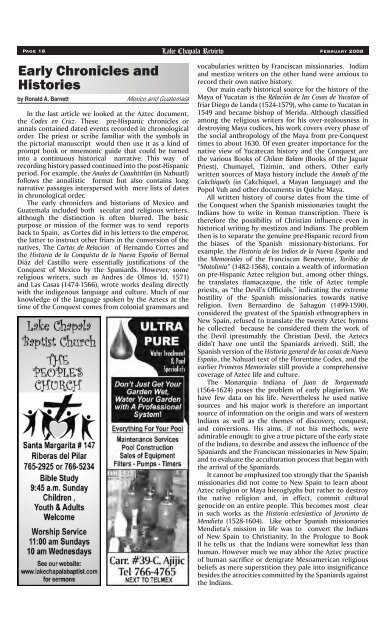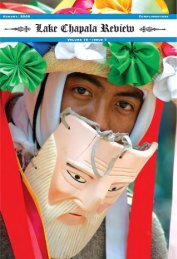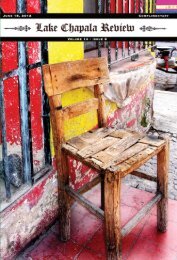Volume 10 - Issue 1, February 15, 2008 - Lake Chapala Review
Volume 10 - Issue 1, February 15, 2008 - Lake Chapala Review
Volume 10 - Issue 1, February 15, 2008 - Lake Chapala Review
Create successful ePaper yourself
Turn your PDF publications into a flip-book with our unique Google optimized e-Paper software.
Page 18 <strong>Lake</strong> <strong>Chapala</strong> <strong>Review</strong><br />
<strong>February</strong> <strong>2008</strong><br />
Early Chronicles and<br />
Histories<br />
by Ronald A. Barnett Mexico and Guatemala<br />
In the last article we looked at the Aztec document,<br />
the Codex en Cruz. These pre-Hispanic chronicles or<br />
annals contained dated events recorded in chronological<br />
order. The priest or scribe familiar with the symbols in<br />
the pictorial manuscript would then use it as a kind of<br />
prompt book or mnemonic guide that could be turned<br />
into a continuous historical narrative. This way of<br />
recording history passed continued into the post-Hispanic<br />
period. For example, the Anales de Cuauhtitlan (in Nahuatl)<br />
follows the annalistic format but also contains long<br />
narrative passages interspersed with mere lists of dates<br />
in chronological order.<br />
The early chroniclers and historians of Mexico and<br />
Guatemala included both secular and religious writers,<br />
although the distinction is often blurred. The basic<br />
purpose or mission of the former was to send reports<br />
back to Spain, as Cortes did in his letters to the emperor,<br />
the latter to instruct other friars in the conversion of the<br />
natives. The Cartas de Relación of Hernando Cortes and<br />
the Historia de la Conquista de la Nueva España of Bernal<br />
Diáz del Castillo were essentially justifications of the<br />
Conquest of Mexico by the Spaniards. However, some<br />
religious writers, such as Andres de Olmos (d. <strong>15</strong>71)<br />
and Las Casas (1474-<strong>15</strong>66), wrote works dealing directly<br />
with the indigenous language and culture. Much of our<br />
knowledge of the language spoken by the Aztecs at the<br />
time of the Conquest comes from colonial grammars and<br />
vocabularies written by Franciscan missionaries. Indian<br />
and mestizo writers on the other hand were anxious to<br />
record their own native history.<br />
Our main early historical source for the history of the<br />
Maya of Yucatan is the Relación de las Cosas de Yucatan of<br />
friar Diego de Landa (<strong>15</strong>24-<strong>15</strong>79), who came to Yucatan in<br />
<strong>15</strong>49 and became bishop of Merida. Although classified<br />
among the religious writers for his over-zealousness in<br />
destroying Maya codices, his work covers every phase of<br />
the social anthropology of the Maya from pre-Conquest<br />
times to about 1630. Of even greater importance for the<br />
native view of Yucatecan history and the Conquest are<br />
the various Books of Chilam Balam (Books of the Jaguar<br />
Priest), Chumayel, Tizimin, and others. Other early<br />
written sources of Maya history include the Annals of the<br />
Cakchiquels (in Cakchiquel, a Mayan language) and the<br />
Popol Vuh and other documents in Quiche Maya.<br />
All written history of course dates from the time of<br />
the Conquest when the Spanish missionaries taught the<br />
Indians how to write in Roman transcription. There is<br />
therefore the possibility of Christian influence even in<br />
historical writing by mestizos and Indians. The problem<br />
then is to separate the genuine pre-Hispanic record from<br />
the biases of the Spanish missionary-historians. For<br />
example, the Historia de los Indios de la Nueva España and<br />
the Memoriales of the Franciscan Benevente, Toribio de<br />
“Motolinia” (1482-<strong>15</strong>68), contain a wealth of information<br />
on pre-Hispanic Aztec religion but, among other things,<br />
he translates tlamacazque, the title of Aztec temple<br />
priests, as “the Devil’s Officials,” indicating the extreme<br />
hostility of the Spanish missionaries towards native<br />
religion. Even Bernardino de Sahagún (1499-<strong>15</strong>90),<br />
considered the greatest of the Spanish ethnographers in<br />
New Spain, refused to translate the twenty Aztec hymns<br />
he collected because he considered them the work of<br />
the Devil (presumably the Christian Devil, the Aztecs<br />
didn’t have one until the Spaniards arrived). Still, the<br />
Spanish version of the Historia general de las cosas de Nueva<br />
España, the Nahuatl text of the Florentine Codex, and the<br />
earlier Primeros Memoriales still provide a comprehensive<br />
coverage of Aztec life and culture.<br />
The Monarquia Indiana of Juan de Torquemada<br />
(<strong>15</strong>64-1624) poses the problem of early plagiarism. We<br />
have few data on his life. Nevertheless he used native<br />
sources and his major work is therefore an important<br />
source of information on the origin and wars of western<br />
Indians as well as the themes of discovery, conquest,<br />
and conversions. His aims, if not his methods, were<br />
admirable enough: to give a true picture of the early state<br />
of the Indians, to describe and assess the influence of the<br />
Spaniards and the Franciscan missionaries in New Spain;<br />
and to evaluate the acculturation process that began with<br />
the arrival of the Spaniards.<br />
It cannot be emphasized too strongly that the Spanish<br />
missionaries did not come to New Spain to learn about<br />
Aztec religion or Maya hieroglyphs but rather to destroy<br />
the native religion and, in effect, commit cultural<br />
genocide on an entire people. This becomes most clear<br />
in such works as the Historia eclesiastica of Jeronimo de<br />
Mendieta (<strong>15</strong>28-1604). Like other Spanish missionaries<br />
Mendieta’s mission in life was to convert the Indians<br />
of New Spain to Christianity. In the Prologue to Book<br />
II he tells us that the Indians were somewhat less than<br />
human. However much we may abhor the Aztec practice<br />
of human sacrifice or denigrate Mesoamerican religious<br />
beliefs as mere superstition they pale into insignificance<br />
besides the atrocities committed by the Spaniards against<br />
the Indians.




